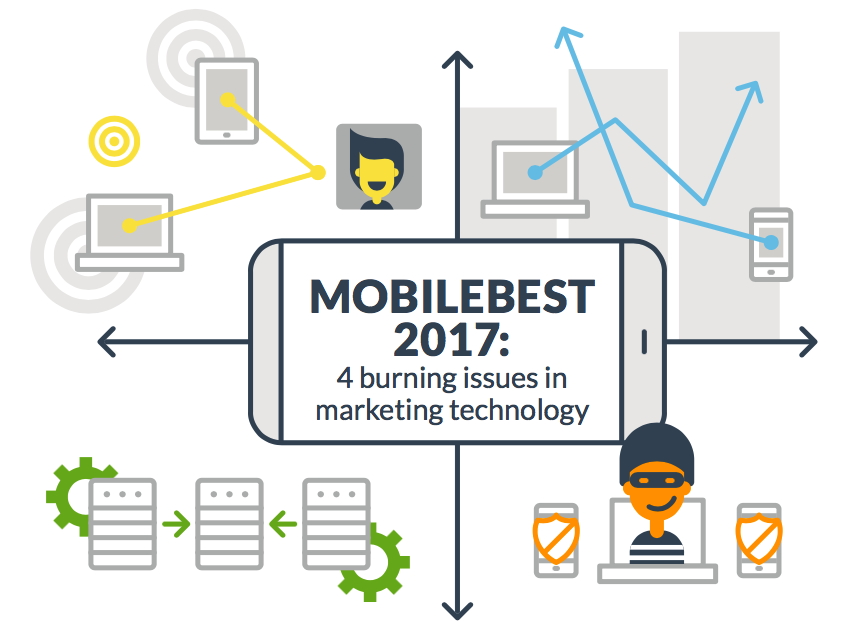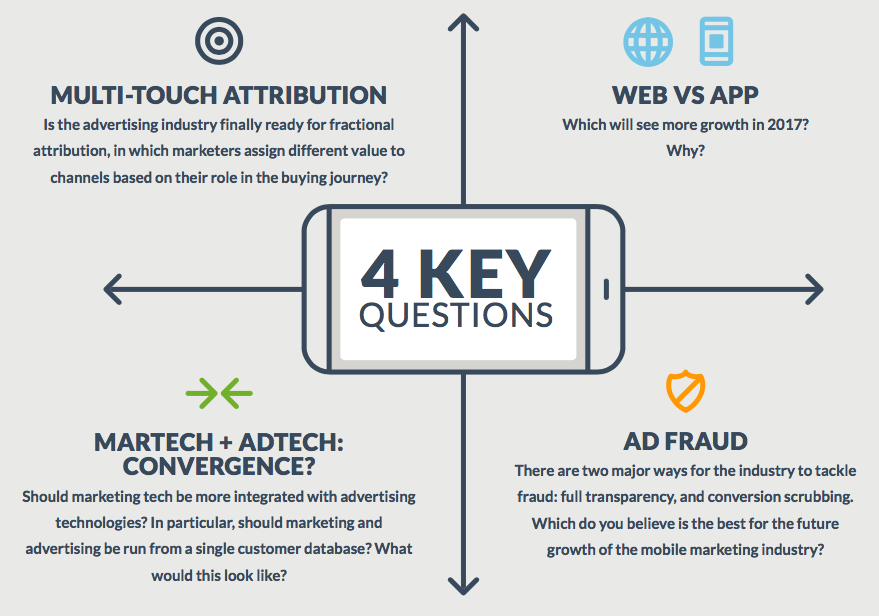
2017 is a key inflection point for marketing.
Walled gardens control advertising to billions of people. Metrics from major platforms show serious flaws, generally in favor of those platforms. We’ve passed peak app, and mobile web is rebounding with the help of accelerated mobile pages and instant articles. Privacy is an issue like never before. Ad fraud impacts as much as a third of mobile ads, and Russian hackers are siphoning $3-5 million/day from video advertiser budgets.

Scott Brinker, CTO of ion interactive, editor of chiefmartec.com, chair of MarTech conference
And yet, somehow, it all still works.
Smart advertisers connect to interested consumers. Mobile apps make tens of millions a week. Brands find ways to engage with audiences. And marketers cut through the clutter of 4,000 tools to find and use the technology that manages and runs their campaigns and adspend.
But we need to make it much, much better.
- Brands need simple tools that combine marketing and advertising data in one simple open platform
- Advertisers need to be able to manage, measure, and attribute campaigns on web, mobile, and any other platform they choose to use
- Marketers need better aggregated data that clearly illuminates the customer journey and shows the value of each point on that map
- CMOs need assurances that dollars they spend go to reaching, engaging, and winning customers, not cheaters
10 world-class industry experts
We asked ten world-class industry experts for their opinions on the state of marketing and advertising, and where it’s going in 2017.

JANET TRAN leads mobile strategy/initiatives for the OpenTable brand on a global scale
They include Scott Brinker, Mr. Martech himself. Liz Miller, the SVP the CMO Council. Mike Brooks, who leads global app advertising at AOL/Verizon. Jean-Louis Gassée, legendary VC and former Apple executive. Janet Tran, who leads mobile for OpenTable.
We’ve also got Dan Slagen, now at Alignable and formerly at HubSpot and Nanigans. James Peng, who leads mobile growth for the Match Group, one of the biggest dating services on the planet. Layne Cox, now at Ibotta and formerly at GrubHub, and Peter Hamilton, CEO of TUNE, round out our experts.
At TUNE, we’re building solutions for marketers in a MobileBest world. That means people-first solutions, not device-first. It means apps, absolutely. It also means mobile web … and even desktop web, which continues to matter. It means smartwatches and smart TVs, smart homes and IoT.
Very simply, MobileBest means that what’s best for your customer is what’s best for your brand.
We asked ten experts four key questions about the biggest trends impacting marketing and advertising in the coming year.
4 key questions on martech & adtech
Technology is changing. CMOs are requiring visibility into the results of the dollars they spend. And fraud is, apparently, a growth industry.

JAMES PENG leads mobile growth at Match Group, and is focused on driving mobile as the vehicle to transform businesses
So we asked our ten experts the most pertinent questions MobileBest digital marketers need answers on today:
- Multi-touch attribution
Is the advertising industry finally ready for fractional attribution, in which marketers assign different value to channels based on their role in the buying journey? - Web vs app
Which will see more growth in 2017? Why? - Martech + adtech: convergence?
Should marketing tech be more integrated with advertising technologies? In particular, should marketing and advertising be run from a single customer database? What would this look like? - Ad fraud
There are two major ways for the industry to tackle fraud: full transparency, and conversion scrubbing. Which do you believe is the best for the future growth of the mobile marketing industry?
Why are these critical issues?
Multi-touch attribution will tie marketers’ ad dollars and total marketing spend more accurately to results. Building for both apps and the web, in the right way, will lead to more customers at the top of the funnel and at the bottom. Integrating martech and adtech will help marketers plan for, understand, and utilize all of a brands’ touches on a consumer, which will enable more personalized service, solutions, and marketing. And fixing ad fraud will give marketers confidence that their budgets are not being wasted.
You can get all of their answers in our just-released MobileBest 2017 white paper, but here’s a sample …
On multi-touch attribution
Q: Is the advertising industry finally ready for fractional attribution, in which marketers assign different value to channels based on their role in the buying journey?

LIZ MILLER is SVP Marketing for the CMO Council, and was formerly SVP at GlobalFluency
Dan Slagen:
“Yes. This is lead scoring for mobile ad campaigns.”
Mike Brooks:
“Marketers’ spend portfolios are becoming too diverse to have a single mobile click guide the way they spend money!”
Olivier Voute:
Yes and no. Applying different bidding strategies due to cross-device effects is taking place but it is not fully automated and doesn’t apply to all channels yet.
Liz Miller:
“I think that we need it, but I’m not sure if we’re really ready for it. It’s almost as if attribution needs a rebrand … we got so burned by single-point attribution, we almost have PTSD from it, and we’re a little gun-shy about multi-touch attribution.”
(Get their full answers — and all the answers.)
On web vs app
Q: Which will see more growth in 2017? Why?

JEAN-LOUIS GASSÉE has spent 48+ yrs in tech at HP, Apple, and as a venture capitalist
Jean-Louis Gassée:
Apps. Trend to mobile where apps dominate.
Layne Cox:
To me apps are all about loyalty and usage while mobile web is about experience and impulse. They both will continue to grow in 2017, but …
Scott Brinker:
In aggregate it almost doesn’t matter. What touchpoints are going to be best in context of an specific company and its customers is the question …
(Get their full answers — and all the answers.)
Martech + adtech: convergence?
Q: Should marketing tech be more integrated with advertising technologies? In particular, should marketing and advertising be run from a single customer database? What would this look like?

CEO of TUNE, former CMO, a decade in marketing technology
Scott Brinker:
Absolutely. You can’t talk about a unified customer journey and then perpetuate internal (martech) and external (adtech) marketing data and operational silos.
Liz Miller:
You just asked the burning question of 2017 … we need that open stack umbrella that will bring all these points into convergence …”
Peter Hamilton:
It is no secret that this is the holy grail for marketers. The biggest hole in marketing clouds and analytics systems today is their connection to the top of the funnel.
(Get their full answers — and all the answers.)
Ad Fraud
Q: There are two major ways for the industry to tackle fraud. Which do you believe is the best for the future growth of the mobile marketing industry?
- Full transparency and a shared view of suspected fraudulent activity between marketers and ad partners?
- Scrubbing of conversions passed to ad partners, so ad partners cannot claim credit for actions that are viewed as fraudulent by the advertiser or measurement partner?

CMO at Alignable. Formerly at HubSpot. Featured in NYT. Frequent speaker/writer
James Peng:
Full transparency and a shared view of suspected fraudulent activity between marketers and ad partners.
Janet Tran:
Full transparency is what advertisers crave today when buying mobile inventory. It’s really important to have a full grasp of where your traffic source is coming from. It’s a huge issue that we’re facing today at OpenTable and we go through great lengths to combat fraudulent installs/activity.
Mike Brooks:
All growing, sustainable businesses trend towards transparency.
On the MobileBest journey
At TUNE, we’re building people-centric products for 2017 that integrate marketing and advertising seamlessly.
We’re building them MobileBest: with the belief that mobile is the first and most important way to reach customers, but the understanding that there’s more to the world than apps.
 The result will be a database of record for prospects and customers that marketing and advertising efforts can draw from, feed, and enrich simultaneously, which synchronizes martech and adtech. This allows for very rich full-spectrum campaigns that include email marketing, web, in-app experiences, video, social, and other advertising across the full range of digital media. And it enables seamless comprehension of the entire customer journey across both web and apps.
The result will be a database of record for prospects and customers that marketing and advertising efforts can draw from, feed, and enrich simultaneously, which synchronizes martech and adtech. This allows for very rich full-spectrum campaigns that include email marketing, web, in-app experiences, video, social, and other advertising across the full range of digital media. And it enables seamless comprehension of the entire customer journey across both web and apps.
In addition, we continue to make it easier and easier for marketers to implement and manage complex multi-touch attribution models, giving advertisers unparalleled ability to know what levers and dials contribute to their results, and take appropriate future action.
Finally, our focus on ad fraud starts with a deterministic view of revenue attribution. Where revenue is the core metric, fraud is helpless over the long term. In addition, we’re building smart systems that sense questionable traffic patterns quickly and warn marketers. We’ve already used early versions of this technology to save individual marketers hundreds of thousands of dollars.
Our goal is to build what marketers would build themselves, if they could.
Author
Before acting as a mobile economist for TUNE, John built the VB Insight research team at VentureBeat and managed teams creating software for partners like Intel and Disney. In addition, he led technical teams, built social sites and mobile apps, and consulted on mobile, social, and IoT. In 2014, he was named to Folio's top 100 of the media industry's "most innovative entrepreneurs and market shaker-uppers." John lives in British Columbia, Canada with his family, where he coaches baseball and hockey, though not at the same time.






Leave a Reply
You must be logged in to post a comment.